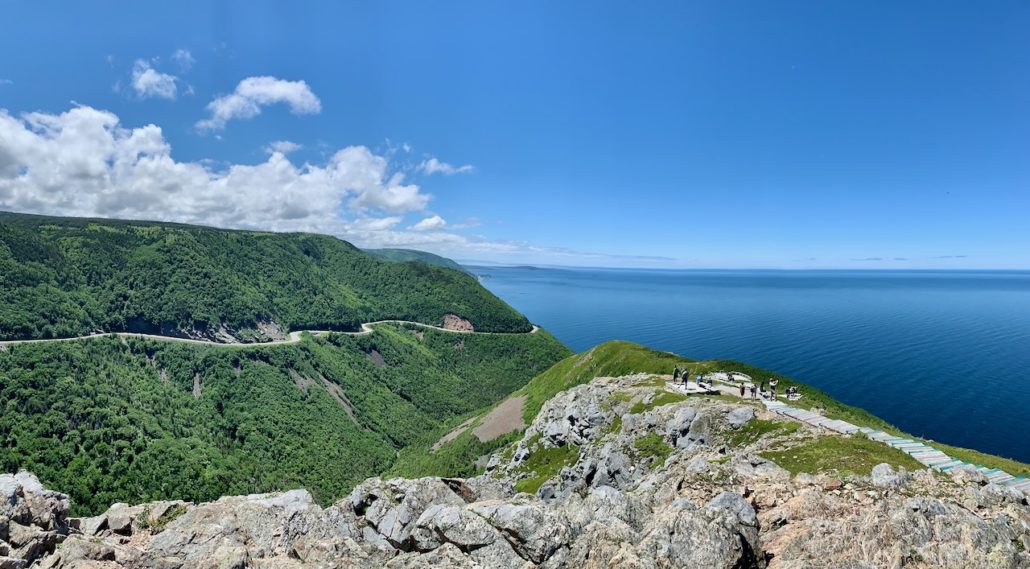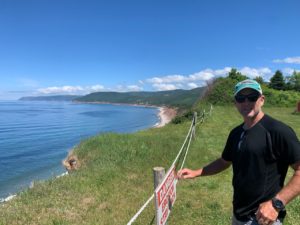Why a Micro-Adventure Can Be Just as Thrilling
Hello and welcome back! It’s summertime and I’m thinking a lot about how travel and adventure can be transformational. But it doesn’t have to be epic. It can be right in your backyard! Read on.
Recently my wife and I set off with our friends Kris and Susan to bicycle around the famed Cabot Trail in Cape Breton Island, Nova Scotia. Cape Breton Island sits at the far eastern end of Nova Scotia, overlooking the remote Gulf of St. Lawrence, home to migrating whales. The Cabot Trail is a gorgeous park road encircling the island, undulating with the rugged coastline.
On the left above is the roadway skirting Cape Breton Highlands National Park on the climb up French’s Mountain. On the right (where I took this photo after that long cycling climb) is the Skyline Trail footpath facing north into the open Gulf of St. Lawrence. The four of us had been dreaming, and planning, for this trip for a few years. Finally, after the Canadian border opened, the timing was right.
Together, my wife and friends can recount every mile of the road cycling, each kind conversation we had along the way, every interesting cabin or campsite we stayed, and likely every game of cards as well. It’s the nature of travel and adventure that makes travel experiences indelible. Travel opens your mind, stretches your boundaries, and ignites new passions.
While I’m writing this to argue that you should plan, and commit, to an epic travel adventure of your own to deepen your relationship with your companions, novel places in the world, and even yourself, I’m also writing this to suggest that adventures don’t always need to be so epic, distant, and planned. You can have a micro-adventure right out your own front door.
“A micro-adventure is an adventure that is short, simple, local, cheap — yet still fun, exciting, challenging, refreshing and rewarding.”
-Alastair Humphreys
Alastair Humphreys once bicycled 46,000 miles around the world over a few years, and was described in 2012 by National Geographic as “Adventurer of the Year.” But he also coined the now common term “micro-adventure.” National Geographic asked him what his own favorite micro-adventure was, and he said:
“The River Thames is thought of as this horrible river. If you go a little ways out of London it becomes a nice countryside river. I decided to swim it. If you jump into the river, the banks are a meter above your head and you can’t see any houses at all. You feel like you are completely in wilderness. I spent two days swimming down the river, sleeping on the banks.”
Well, Humphries thinks swimming in the River Thames for a couple days is a “micro-adventure.” That might not feel quite micro to us. However, he also spends about 15 minutes once each month climbing the same tree in his backyard to observe the changing of the seasons, and the changing of the tree.
Here’s what a micro-adventure is and why you should do it. A micro-adventure doesn’t have to be a months-long elaborate undertaking of planning, requiring lots of new gear, map studying, and cajoling friends to join. A micro-adventure is meant to be a concentrated, short, intense – and new – experience, with all of the same refreshing physical, mental and spiritual benefits.
Sleep in your backyard, hike by the full moon, or even try cooking a new recipe. One of my favorite small adventures is to try something that is new to you, but with a friend who is skilled. For example, I would likely not take myself surfing, but when I surf with our son, he knows where to go, how to prepare, the social conventions of the line-up, and when to drop in without offending someone. He even knows where the best sandwich is afterwards.
I once read about a father-daughter micro-adventure in which they intentionally parked a mile or two away from their destination, turned off their phones, and asked directions to navigate the city. Perfect mini adventure. You get to be present, mindful, and solve a fun problem. Together.
Here’s a photo of our friend Kris in full adventure mode with us in Cape Breton.
Go forth and create a new adventure of any size!
________________________________________________
Recently I wrote about Mindscaling’s big project to convert Faisal Hoque’s book, LIFT into an interactive learning documentary. You can see previews of that elearning project, and his important new book here. Our company Mindscaling, is busy building powerful online micro-learning experiences to drive the human change that propels your team. You can find our catalog of high-impact courses here. And if you want something more tailored, you can learn about our custom work here.
My book Small Acts of Leadership, is a Washington Post bestseller! You can grab a copy here. And if you want to learn to apply some of these ideas and be an effective coach for your team, we wrote a course on that too. It’s called Coaching for Managers available over at UDEMY for Business.





